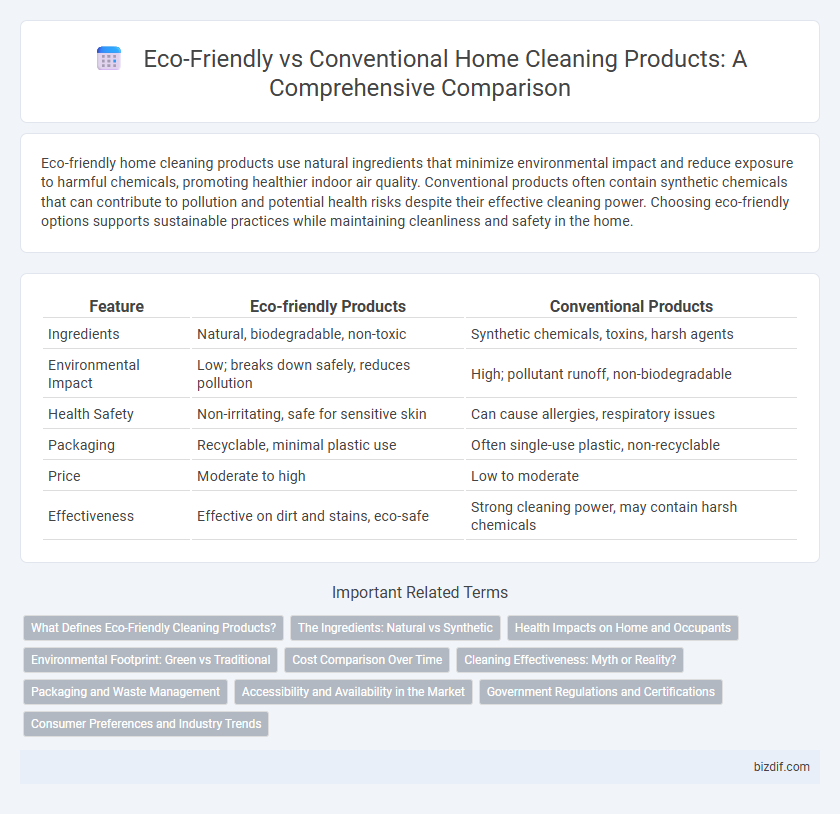Eco-friendly home cleaning products use natural ingredients that minimize environmental impact and reduce exposure to harmful chemicals, promoting healthier indoor air quality. Conventional products often contain synthetic chemicals that can contribute to pollution and potential health risks despite their effective cleaning power. Choosing eco-friendly options supports sustainable practices while maintaining cleanliness and safety in the home.
Table of Comparison
| Feature | Eco-friendly Products | Conventional Products |
|---|---|---|
| Ingredients | Natural, biodegradable, non-toxic | Synthetic chemicals, toxins, harsh agents |
| Environmental Impact | Low; breaks down safely, reduces pollution | High; pollutant runoff, non-biodegradable |
| Health Safety | Non-irritating, safe for sensitive skin | Can cause allergies, respiratory issues |
| Packaging | Recyclable, minimal plastic use | Often single-use plastic, non-recyclable |
| Price | Moderate to high | Low to moderate |
| Effectiveness | Effective on dirt and stains, eco-safe | Strong cleaning power, may contain harsh chemicals |
What Defines Eco-Friendly Cleaning Products?
Eco-friendly cleaning products are defined by their use of biodegradable, non-toxic ingredients derived from renewable resources that minimize environmental impact. These products avoid harmful chemicals such as phosphates, parabens, and synthetic fragrances that can pollute water systems and harm wildlife. Certifications like EPA Safer Choice and Green Seal help identify formulations that prioritize human health and ecological sustainability over conventional alternatives.
The Ingredients: Natural vs Synthetic
Eco-friendly home cleaning products primarily use natural ingredients such as plant-based surfactants, essential oils, and biodegradable compounds that minimize environmental impact. Conventional products often contain synthetic chemicals like phosphates, ammonia, and artificial fragrances, which can be harmful to health and ecosystems. Choosing natural ingredients reduces exposure to toxins and supports sustainable living by promoting safer biodegradation.
Health Impacts on Home and Occupants
Eco-friendly cleaning products reduce exposure to harmful chemicals, lowering the risk of respiratory issues, allergies, and skin irritations for home occupants. Conventional products often contain volatile organic compounds (VOCs) and toxic substances that can linger in indoor air, negatively affecting air quality and occupant health. Choosing biodegradable, non-toxic cleaners promotes a safer living environment and minimizes long-term health risks associated with chemical residues.
Environmental Footprint: Green vs Traditional
Eco-friendly home cleaning products significantly reduce environmental footprint by using biodegradable ingredients and sustainable packaging, minimizing water and air pollution compared to conventional products. Traditional cleaning products often contain harsh chemicals and non-renewable resources that contribute to greenhouse gas emissions and toxic waste accumulation. Choosing green alternatives supports ecosystem health by lowering carbon emissions and reducing chemical runoff into waterways.
Cost Comparison Over Time
Eco-friendly home cleaning products often have a higher upfront cost than conventional alternatives but tend to save money over time due to their concentrated formulas and reduced packaging waste. Conventional products may appear cheaper initially but can lead to higher long-term expenses because of frequent repurchasing, potential health-related costs, and environmental cleanup fees. Investing in sustainable cleaning solutions promotes cost efficiency through durability and reduced environmental impact, making them economically advantageous in the extended run.
Cleaning Effectiveness: Myth or Reality?
Eco-friendly cleaning products often contain natural enzymes and plant-based surfactants that effectively break down dirt and grime, challenging the myth that only conventional products provide strong cleaning power. Studies show that many eco-friendly formulations achieve comparable, and sometimes superior, results in removing stains and disinfecting surfaces without harsh chemicals. Consumer reports and laboratory tests highlight that cleaning effectiveness depends more on product formulation and usage techniques than on whether the product is eco-friendly or conventional.
Packaging and Waste Management
Eco-friendly home cleaning products utilize biodegradable, recyclable, or refillable packaging to significantly reduce landfill waste compared to conventional products that often rely on single-use plastics and non-recyclable materials. Waste management benefits from eco-friendly options as these products minimize chemical residues and promote sustainable disposal practices, contributing to lower environmental pollution. Choosing eco-friendly packaging supports circular economy principles by encouraging reuse and reducing reliance on virgin plastic production.
Accessibility and Availability in the Market
Eco-friendly home cleaning products are increasingly accessible, with many retailers and online platforms offering a wide range of biodegradable and non-toxic options. Conventional cleaning products remain more widely available in supermarkets and convenience stores, often at lower prices, making them a convenient choice for many consumers. The growing demand for sustainable living is driving broader market availability and improved distribution channels for eco-friendly alternatives.
Government Regulations and Certifications
Government regulations increasingly mandate the use of eco-friendly cleaning products by enforcing strict limits on volatile organic compounds (VOCs) and toxic chemicals commonly found in conventional products. Certifications such as Green Seal, EPA's Safer Choice, and EU Ecolabel validate the safety and environmental impact of cleaning agents, guiding consumers toward sustainable choices. Compliance with these standards not only reduces indoor air pollution but also minimizes ecological damage from chemical runoffs, promoting healthier homes and communities.
Consumer Preferences and Industry Trends
Eco-friendly home cleaning products have gained significant consumer preference due to increasing awareness of health and environmental impacts, with market data showing a steady rise in demand for biodegradable and non-toxic ingredients. Conventional cleaning products, despite their effectiveness and lower cost, face declining popularity as consumers prioritize sustainability and safety for indoor air quality. Industry trends highlight a shift towards plant-based formulations, transparent labeling, and certifications such as EPA Safer Choice to meet evolving customer expectations.
Eco-friendly products vs Conventional products Infographic

 bizdif.com
bizdif.com